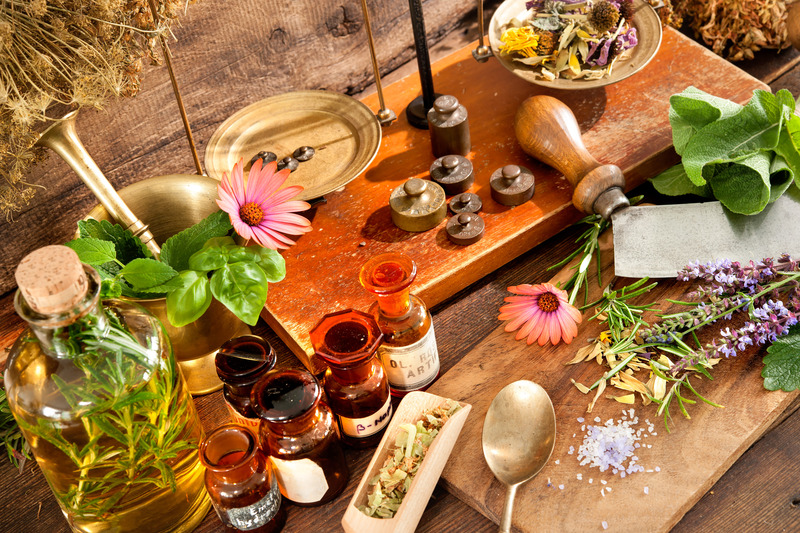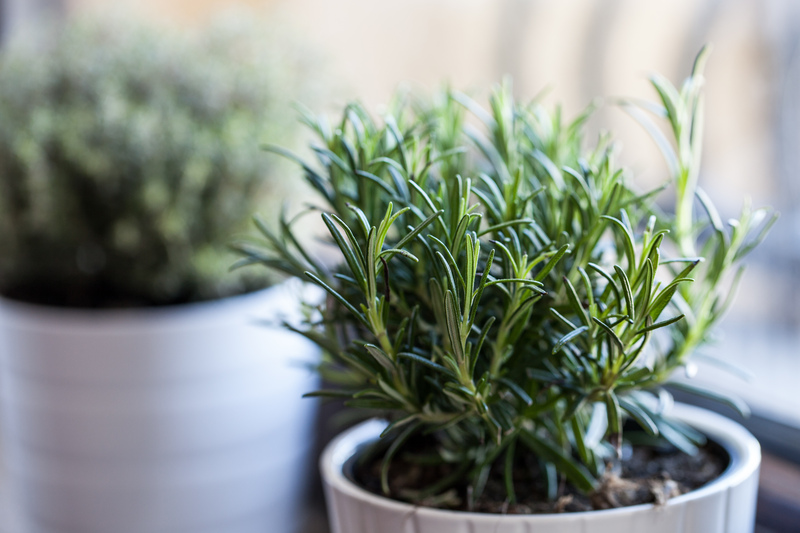Designing a Vibrant Herb Garden
Posted on 29/08/2025
Designing a Vibrant Herb Garden: Your Complete Guide
Imagine stepping into your garden and being greeted by a tapestry of colors, textures, and fragrances, all thanks to a well-designed herb garden. Herb gardens are not only practical and bountiful but also serve as eye-catching features in any outdoor space. This comprehensive guide will walk you through everything you need to know about designing a vibrant herb garden that brings joy, flavor, and natural beauty to your home.
Why Create a Vibrant Herb Garden?
A vibrant herb garden is a fusion of utility and aesthetics. Unlike simple vegetable patches, herb gardens brim with diversity and can transform any dull spot into a living work of art. Here are several benefits of designing a colorful and practical herb garden:
- Fresh Supply of Culinary Herbs: Enjoy parsley, basil, thyme, rosemary, mint, and more right at your fingertips.
- Natural Aromatherapy: Many herbs emit delightful fragrances, making your garden a relaxing haven.
- Year-Round Beauty: With careful selection, you can create texture, color, and seasonal interest throughout the year.
- Support for Pollinators: Many herbs attract bees and butterflies, supporting local ecosystems.
- Health and Wellness: Harvest medicinal herbs for teas and natural remedies.

Planning Your Herb Garden Design
Strategic planning is the key to designing a lush, colorful herb garden that flourishes year after year. Before you put shovel to soil, consider these vital factors:
Choosing the Right Location
Most herbs thrive in full sun. Select a spot that receives at least six to eight hours of sunlight daily. Observe your garden's exposure throughout the day, taking note of any shade from nearby trees or structures.
Well-drained soil is essential. If your chosen site retains water, consider building raised beds or installing proper drainage solutions.
Garden Layout Options for a Colorful Display
How you arrange your herbs can dramatically impact the vibrancy and usability of your garden. Here are several popular design strategies:
- Knot Gardens: Traditional, geometric patterns outlined with low hedges (like thyme or lavender).
- Container Gardens: Ideal for patios or small spaces; group pots of varying sizes and colors for a lively effect.
- Vertical Herb Walls: Utilize small spaces with vertical planters for a lush, green tapestry.
- Spiral Herb Beds: A three-dimensional, space-saving solution that provides multiple microclimates for diverse herbs.
- Border Gardens: Use herbs as living borders along paths or the edges of flower beds for extra color and scent.
Soil Preparation for Maximum Vitality
Healthy soil is the backbone of a vibrant herb garden. Test your soil pH; most herbs prefer a slightly alkaline to neutral range (pH 6.0-7.5). Enhance your soil by incorporating:
- Organic compost for nutrients and soil structure enhancement
- Coarse sand or perlite to improve drainage, especially in clay-heavy soils
- Mulch to retain moisture and suppress weeds
Tip: Amend your soil several weeks before planting to let nutrients settle and microbial life flourish.
Selecting Herbs for a Lively and Diverse Garden
Choosing the right herbs for a vibrant garden design requires considering not just flavor, but also color, growth habit, and seasonal interest. When planning, opt for a mix of:
- Perennial herbs (e.g., lavender, rosemary, sage, thyme) for structure and year-round greenery
- Annual herbs (e.g., basil, dill, cilantro, summer savory) for bursts of seasonal color and aroma
- Biennial herbs (e.g., parsley, caraway) for variety and staggered growth
Herbs With Striking Foliage and Flowers
Add visual drama to your herb garden by incorporating plants with colorful foliage or flowers. Here are some top choices:
- Purple Basil: Deep purple leaves enhance any planting scheme and are delicious in salads.
- Variegated Sage: Cream-and-green mottled leaves with purple flowers in spring.
- Pineapple Sage: Vivid red blossoms that attract hummingbirds and edible, pineapple-flavored leaves.
- Chive Blossoms: Clusters of pink-purple flowers, wonderful for both borders and salads.
- Calendula: Bright orange or yellow blooms, technically a medicinal herb, that lights up the garden.
- Fennel: Feathery, bronze or green foliage with unmistakable yellow umbels.
Diversifying the color and texture of your herbs keeps your garden visually exciting throughout the seasons.
Edible and Medicinal Value
Your herb garden can be as functional as it is beautiful. Choose herbs for teas, culinary uses, garnishes, or home remedies:
- Lemon Balm: Uplifting flavor for teas and desserts, plus soothing medicinal qualities.
- Mint: Ideal for fresh drinks, desserts, and even as a natural pest repellent.
- Lavender: Adds flavor to syrups and baked goods, and also used for relaxation and skincare.
- Chamomile: Classic herbal tea ingredient, with dainty white flowers attracting pollinators.
Design Principles for a Dynamic Herb Garden
Applying key garden design principles ensures your herb garden will be both practical and breathtaking.
Color Coordination and Plant Placement
Combine complementary and contrasting colors by mixing green, purple, silver, and gold leaved herbs. Group herbs according to their size and growth habits -- place taller varieties (like fennel and rosemary) at the back, shorter ones (like thyme and oregano) at the front. This layering ensures all your plants get sunlight and are easily accessible for harvesting.
- Cohesion: Repeat colors, shapes, or textures throughout the herb garden for a unified look.
- Contrast: Place silvery-leaved sage beside purple basil, or feathery dill near upright chives, to create visual interest.
Incorporating Pathways and Features
Designing a vibrant herb garden involves creating inviting pathways and focal points.
- Gravel or stepping-stone paths make it easy to harvest herbs without compacting the soil.
- Decorative trellises can support climbing herbs like hops or sweet peas (an edible flower pairing well with herbs).
- Water features or birdbaths add soothing sounds and attract beneficial wildlife.
- Garden art and pottery can enhance color and personalization.
Seasonality and Succession Planting
To ensure your garden remains lush and colorful throughout the year, plan for succession planting and staggered bloom times. Use early-blooming chives and calendula, mid-season lavender and sage, and later-flowering pineapple sage or basil in warmer climates.
Maintenance Tips for a Flourishing Herb Garden
Regular maintenance will keep your herb garden bursting with vibrancy and health:
- Watering: Most herbs prefer moderate watering; avoid overwatering, which can lead to root rot.
- Pruning: Regularly trim herbs to promote bushier, healthier growth and more abundant harvests.
- Mulching: Add mulch to conserve moisture, regulate temperature, and suppress weeds.
- Fertilizing: Use compost or a balanced organic fertilizer sparingly for the best flavor.
- Pest Management: Most herbs naturally deter pests, but keep an eye out for aphids and snails.
- Dividing and Moving: Every few years, divide perennials like mint and chives to prevent overcrowding and keep plants robust.
Quick tip: Frequent harvesting keeps plants vigorous and prevents them from going to seed prematurely.
Creative Ideas to Maximize Vibrancy
Go beyond the basics to make your herb garden a true showstopper:
- Companion Planting: Plant flowering herbs alongside vegetables to boost pollination and repel pests.
- Colorful Containers: Use painted pots or mosaic planters to add pops of color among your herbs.
- Themed Gardens: Try a cocktail herb garden (mint, lemon verbena, basil, borage) or a tea herb garden (chamomile, lemon balm, peppermint).
- Living Edges and Borders: Create living borders with thyme, oregano, or creeping savory.
- Edible Flowers: Incorporate edible blossoms like nasturtiums, calendula, and violets for a captivating look and culinary use.
Common Mistakes to Avoid in Herb Garden Design
To ensure success when designing a vibrant herb garden, steer clear of these frequent pitfalls:
- Overcrowding: Give each herb enough space to reach mature size -- check planting distances on seed packets.
- Poor Drainage: Avoid low spots or heavy soils that retain water; herbs hate soggy roots!
- Ignoring Microclimates: Don't plant shade-loving herbs like parsley in full sun, or drought-tolerant herbs in wet areas.
- Neglecting Harvests: Not harvesting often enough can lead to woody, unproductive plants.
- Mixing Invasive Herbs: Some herbs, like mint and lemon balm, spread aggressively. Plant them in containers to keep them contained.
Herb Garden Design for Small Spaces
You don't need sprawling lawns to create a lush, lively herb garden. Consider these compact solutions:
- Windowsill Planters: Brighten up indoor spaces with a row of colorful, aromatic herbs.
- Hanging Baskets: Trailing herbs like oregano and thyme can cascade from hanging pots.
- Pocket Planters: Vertical fabric or wooden planters make excellent use of sunny walls or fences.
- Stackable Containers: Tower-style pots allow many herbs to grow in a tight footprint.

Bringing Your Herb Garden to Life Year After Year
A truly vibrant herb garden design is a dynamic, evolving project. Try new varieties each season, experiment with color combinations, and rotate your plantings to keep the soil healthy. Invite your family or community to join in the planting and harvesting for a shared, hands-on experience.
Conclusion
Designing a vibrant herb garden is a deeply rewarding endeavor that blends beauty, flavor, and practicality. By carefully selecting your site, preparing your soil, choosing a wide variety of decorative and useful herbs, and applying clever design principles, you'll create a stunning outdoor sanctuary overflowing with fragrance and life. Start planning your vibrant herb garden today--and watch as your home transforms into a thriving oasis of color, taste, and inspiration!
Happy gardening!

